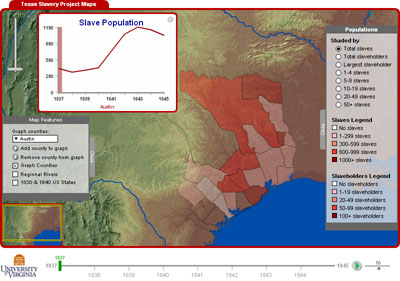A Historian’s View of VisualEyes
(Née HistoryBrowser)Andrew J. Torget, Ph.D.
University of North TexasThe HistoryBrowser is a platform for the visualization and dynamic manipulation of historical information. Historians have long been awash in discrete piles of data representing particular moments in time: census returns every decade, electoral returns every two years, diaries that represent the daily happenings of someone’s life. Each of these historical records are, in effect, isolated snapshots of a unique time and place. For most historians, the use of such data has usually been limited to talking about those datasets in isolation (such as information from a particular census year) or finding discrete connections by comparing isolated aspects of the data (such as comparing the census returns with electoral returns for a certain county).
It has proven far more difficult for us to imagine the evolution of change over time that combinations of those datasets represent, usually forcing us to examining these moments in time individually. The HistoryBrowser frees the historian from such restrictions by allowing the user to manipulate multiple sets of data simultaneously, rendering complex visualizations of historical information spread across time that can reveal relationships and historical processes embedded in the datasets which would not otherwise be apparent.
Like all good historical tools, the HistoryBrowser is foremost driven by questions. Let us imagine there is a historian of slavery, for example, who wishes to understand why slaveholders in nineteenth-century Texas established their plantations in certain parts of the region rather than in others. Using the HistoryBrowser, he or she could take existing census data of slave and slaveholder populations to create a map of where people lived in the region and how those populations changed over the years.
By allowing the historian to combine census data with geography, the HistoryBrowser creates a visual index of the multiple census returns, plotting information across both time and space. The HistoryBrowser, however, allows the historian to bring in other relevant information that will shed more light on these particular census returns.
By relating the census to known information about the geology of the region, the HistoryBrowser can render maps of increasing depth and complexity that demonstrate the relationships between datasets (such as whether slaveholders established plantations in areas with the best soil types, regional elevations, and local water systems). The same could be done with electoral data (allowing the historian to see visualizations of the relationships that existed between slave and slaveholder populations and how people voted in a given election) or any other set of information that could shed light on the question at hand.
If our historian of slavery in Texas wanted to know whether slaveholders in the region established plantations in the regions with the best soil, the best watered lands, nearest established roads, or closest to the United States border, the HistoryBrowser will provide him or her with the tools to make those discoveries.
The HistoryBrowser goes beyond those tasks, however, by allowing the historian to transform their multiple datasets into any number of different visualizations, such as charts or graphs, and then ask new questions of the data based on those visualizations. Because the information used by the HistoryBrowser is fully dynamic, historians can use its visualizations to determine what particular information is most relevant to their question and then ask the HistoryBrowser for that information.
In all of this, the HistoryBrowser seeks to make relationships and patterns embedded in the historical record both visible and apparent, while also empowering the historian to quickly find answers to their questions. And that makes it a tool that opens new possibilities to historians.
---
Andrew Torget is an assistant professor at the University of North Texas. He is collaborating with VCDH using HistoryBrowser for his Texas Slavery Project.
